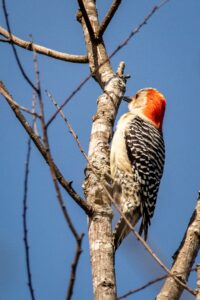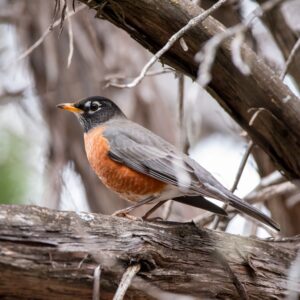 That is why I tell you not to worry about everyday life …..Matthew 6:25
That is why I tell you not to worry about everyday life …..Matthew 6:25
BAM! There he is again. It’s a common sound at our house in early spring. The male robins are making their presence known. It’s a well-known fact that when male birds see their reflection during mating season, they will likely attack the perceived intruder. Now Ken says that the spring-cleaned glass is just a tempting invitation into our living room, but whatever his reason, the robin certainly gets our attention when he bags against the glass. So far, there have been no broken windows, but we’ve seen a few birds walking funny and probably nursing a giant headache.
We’ve always been told that robins go away for the winter and that when they return, we can count on spring being just around the corner.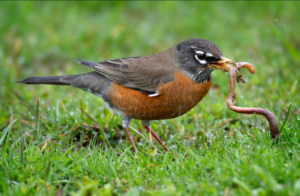 It is true, they are somewhat migratory, but many stay flocked together in nearby wooded areas where they are able to forage for winter’s treasure trove of dried berries and seeds. When the temperature hits the upper thirties, they emerge again, making people think they’ve traveled a long way for a warmer winter season. In truth, they handle the cold quite well and that upper-thirties temperature motivates their favorite food to spring into action. Robins favor earthworms over just about anything in your yard so if your soil supports earthworms, the robins will be there too.
It is true, they are somewhat migratory, but many stay flocked together in nearby wooded areas where they are able to forage for winter’s treasure trove of dried berries and seeds. When the temperature hits the upper thirties, they emerge again, making people think they’ve traveled a long way for a warmer winter season. In truth, they handle the cold quite well and that upper-thirties temperature motivates their favorite food to spring into action. Robins favor earthworms over just about anything in your yard so if your soil supports earthworms, the robins will be there too.
Once the hunt for worms begins, the robin turns its thoughts to nesting and when mates have been chosen, three to five eggs are laid in a nest made of mud, grass, and sticks. They love the long slender dried daylily leaves left in my beds from the previous summer. They nest in very open areas, yet while the trees are still bare, they seem to favor that small, protected area just above our downspouts. We’d much rather they nest in the trees where they belong and our yard has ample trees, so Ken tears down the nests almost daily to keep them from laying eggs there. He doesn’t want to disturb the nest once eggs are laid so he must be persistent to stay ahead of the robins.
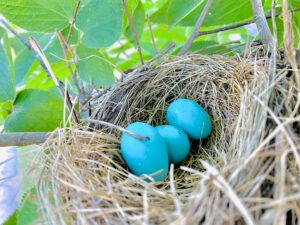 They eventually get the message, head for the trees and we’ll have several nests during the season for each adult pair will raise two or three broods and they don’t re-use a nest. Eggs hatch in fourteen days and the offspring will fledge in another fourteen days, though a little help from mom and dad is still appreciated. The female bird tends the babies while the dad keeps a close watch on the skies for predators who will gladly make a meal of the baby robins and sometimes even the adult birds become prey to a larger bird. The male and female robin will remain monogamous for the summer season and, because robins often return to a successful breeding ground, sometimes they remain together for another summer. They do not, however, mate for life. While some birds may live to a ripe old age, in general, the population of a flock turns over about every six years.
They eventually get the message, head for the trees and we’ll have several nests during the season for each adult pair will raise two or three broods and they don’t re-use a nest. Eggs hatch in fourteen days and the offspring will fledge in another fourteen days, though a little help from mom and dad is still appreciated. The female bird tends the babies while the dad keeps a close watch on the skies for predators who will gladly make a meal of the baby robins and sometimes even the adult birds become prey to a larger bird. The male and female robin will remain monogamous for the summer season and, because robins often return to a successful breeding ground, sometimes they remain together for another summer. They do not, however, mate for life. While some birds may live to a ripe old age, in general, the population of a flock turns over about every six years.
Look at the birds. They don’t plant or harvest or store food in barns, for your heavenly Father feeds them. And aren’t you more valuable to him than they are? Can all your worries add a single moment to your lives? Matthew 6:26
So why all this talk about robins? Well, robins act instinctually and don’t spend their time worrying about “things.” When the earth is warm enough for worms to become active, instinct kicks in and the robins begin their search for food. God has provided berries and seeds for them to survive the cold winter and now he beckons them to the fresh meat that slithers underground. He provides nesting material and new babies to care for as soon as a breath of spring arrives. And the adult robins, well, they just keep doing what robins have always done. So why can’t we take a lesson from them? Why do we continue to worry about everything? Where is our faith in the one who created us in His own image?
warm enough for worms to become active, instinct kicks in and the robins begin their search for food. God has provided berries and seeds for them to survive the cold winter and now he beckons them to the fresh meat that slithers underground. He provides nesting material and new babies to care for as soon as a breath of spring arrives. And the adult robins, well, they just keep doing what robins have always done. So why can’t we take a lesson from them? Why do we continue to worry about everything? Where is our faith in the one who created us in His own image?
Seek the Kingdom of God above all else, and live righteously, and he will give you everything you need.
Matthew 6:33


 What shall I render to the Lord for all His bounty to me. Psalm 116:12
What shall I render to the Lord for all His bounty to me. Psalm 116:12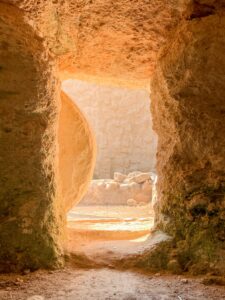
 But here’s the good news. He forgives! Alleluia!
But here’s the good news. He forgives! Alleluia!


 I put all my hope in the Lord. He leaned down to me; he listened to my cry for help. He lifted me out of the pit of death, out of the mud and filth, and set my feet on solid rock. He steadied my legs. Psalm 40:1-2
I put all my hope in the Lord. He leaned down to me; he listened to my cry for help. He lifted me out of the pit of death, out of the mud and filth, and set my feet on solid rock. He steadied my legs. Psalm 40:1-2

 That house next door has been sitting vacant for a few months now. Real estate agents have shown it a number of times to prospective buyers but no sale has happened to date. Lots of questions come to mind when we find ourselves wondering who the next homeowner will be or if the current owner will eventually give up trying to sell and decide to rent the home instead. When a car parks in the driveway, it’s natural to peer out the window to see who might be looking. Is it a young family with active children or empty nesters just getting started on the next phase of life’s journey? Perhaps it’s a retired couple wanting to just enjoy those “golden years.” Maybe it’s a single parent with a whole passel of kids. Are there any pets waiting impatiently in the car? And here’s one for you….is it someone with long hair, a scruffy beard and a flowing robe with sandals on his feet? No, I’m not talking about a 1970s hippie. I’m asking what you’d think if you saw Jesus, the Son of God, looking at that house next door? What thoughts would rush to your mind if you learned that He just might be your new neighbor?
That house next door has been sitting vacant for a few months now. Real estate agents have shown it a number of times to prospective buyers but no sale has happened to date. Lots of questions come to mind when we find ourselves wondering who the next homeowner will be or if the current owner will eventually give up trying to sell and decide to rent the home instead. When a car parks in the driveway, it’s natural to peer out the window to see who might be looking. Is it a young family with active children or empty nesters just getting started on the next phase of life’s journey? Perhaps it’s a retired couple wanting to just enjoy those “golden years.” Maybe it’s a single parent with a whole passel of kids. Are there any pets waiting impatiently in the car? And here’s one for you….is it someone with long hair, a scruffy beard and a flowing robe with sandals on his feet? No, I’m not talking about a 1970s hippie. I’m asking what you’d think if you saw Jesus, the Son of God, looking at that house next door? What thoughts would rush to your mind if you learned that He just might be your new neighbor?
 Next week is Holy Week. On Sunday, we’ll celebrate Jesus’ triumphal entry to Jerusalem. In the early part of the week, we’ll see Him chasing out money-changers from the temple and being questioned by religious leaders. On Thursday, we’ll observe The Last Supper, setting the stage for all that is to follow. On Friday, the dark hours of betrayal, torture, and crucifixion will consume our thoughts. No one knew then what was to come on Sunday, but we do. He tried to tell His closest friends and followers but they didn’t understand. We have the benefit of hindsight, but the question remains; will we live our days responding to the cultural noise and chaos surrounding us or will we welcome into our neighborhood and our hearts the One whose promises have true meaning? Will we recall the words of our praise band last Sunday as they sang; “Your love is so much sweeter than anything I’ve tasted, I want to know your heart.”
Next week is Holy Week. On Sunday, we’ll celebrate Jesus’ triumphal entry to Jerusalem. In the early part of the week, we’ll see Him chasing out money-changers from the temple and being questioned by religious leaders. On Thursday, we’ll observe The Last Supper, setting the stage for all that is to follow. On Friday, the dark hours of betrayal, torture, and crucifixion will consume our thoughts. No one knew then what was to come on Sunday, but we do. He tried to tell His closest friends and followers but they didn’t understand. We have the benefit of hindsight, but the question remains; will we live our days responding to the cultural noise and chaos surrounding us or will we welcome into our neighborhood and our hearts the One whose promises have true meaning? Will we recall the words of our praise band last Sunday as they sang; “Your love is so much sweeter than anything I’ve tasted, I want to know your heart.”

 Maple syrup is a major export for our New England states and, while Vermont is most closely associated with its production, other states look forward to late winter as the birth of a new sugaring season. It’s a tradition that dates back to colonial settlement.
Maple syrup is a major export for our New England states and, while Vermont is most closely associated with its production, other states look forward to late winter as the birth of a new sugaring season. It’s a tradition that dates back to colonial settlement.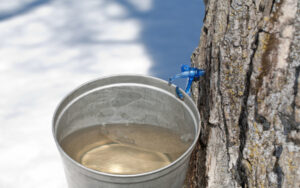
 But we have a personal source we can tap for strength and comfort whenever we need. The only rules are that we try to live as He has instructed us to live and keep in touch with Him on a regular basis. He’ll provide the tools to get the job done if it’s a job that He is asking us to do.
But we have a personal source we can tap for strength and comfort whenever we need. The only rules are that we try to live as He has instructed us to live and keep in touch with Him on a regular basis. He’ll provide the tools to get the job done if it’s a job that He is asking us to do.


 There is one bridge that doesn’t frighten me. It gives me comfort and hope. That bridge is named Jesus. Before His birth, no one could speak to God except the holy men, the priests. But on that day when Jesus died, the curtain between God and man was torn in half, no more intercessors were needed. We were offered a one-on-one relationship, conversations on a first-name basis. It’s a long and sometimes tumultuous journey through this life and we sometimes lose our way.
There is one bridge that doesn’t frighten me. It gives me comfort and hope. That bridge is named Jesus. Before His birth, no one could speak to God except the holy men, the priests. But on that day when Jesus died, the curtain between God and man was torn in half, no more intercessors were needed. We were offered a one-on-one relationship, conversations on a first-name basis. It’s a long and sometimes tumultuous journey through this life and we sometimes lose our way.



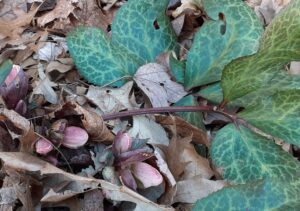 , you say, in January? And there she was, barely visible beneath the bed of leaf mulch we’d provided in late fall. The dark green spotted leaves, leathery in appearance and harsh to the touch because of the spikes at the edges of each leaf, were still alive, though scorched and wind-tattered. Under their protection, I found the object of my search, a cluster of buds waiting to open. They’re sturdy buds, frail bits of fluff wouldn’t stand a chance in our Missouri winters. But she has remarkable capabilities, much like those of her namesake.
, you say, in January? And there she was, barely visible beneath the bed of leaf mulch we’d provided in late fall. The dark green spotted leaves, leathery in appearance and harsh to the touch because of the spikes at the edges of each leaf, were still alive, though scorched and wind-tattered. Under their protection, I found the object of my search, a cluster of buds waiting to open. They’re sturdy buds, frail bits of fluff wouldn’t stand a chance in our Missouri winters. But she has remarkable capabilities, much like those of her namesake.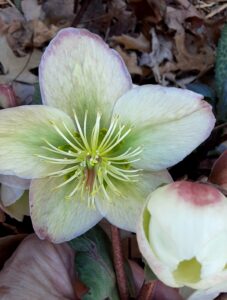 The Lenten Rose has no scientific relationship to the rose. It is, however, related to the buttercup, tracing its roots, pardon the pun, to the genus Helleborus, containing about twenty species in the family Ranunculaceae. In its native Turkey, it could be found growing in more shaded areas and established into large clumps. Here in Missouri, it likes shaded to partly shaded ground with protection from harsh winter weather, in which case it will retain some or all of its dark green leaf color year-round. If it is not protected or our winter is particularly harsh causing its leaves to die back, its perennial traits will bring it back again as spring warms the air.
The Lenten Rose has no scientific relationship to the rose. It is, however, related to the buttercup, tracing its roots, pardon the pun, to the genus Helleborus, containing about twenty species in the family Ranunculaceae. In its native Turkey, it could be found growing in more shaded areas and established into large clumps. Here in Missouri, it likes shaded to partly shaded ground with protection from harsh winter weather, in which case it will retain some or all of its dark green leaf color year-round. If it is not protected or our winter is particularly harsh causing its leaves to die back, its perennial traits will bring it back again as spring warms the air.
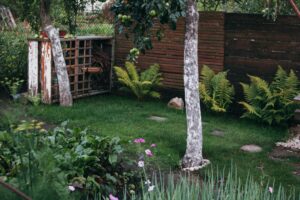 Being the outdoor enthusiasts we are, Ken and I love to make our yard attractive to lots of critters. That means planting perennials, shrubs, and trees that will provide food and habitat as well as winter cover. It also means providing food during harsh winter weather. Our oaks provide lots of acorns for squirrels and other critters who find their well-hidden stashes. Our holly bushes create a safe place for birds and mammals to hide under and within. And when the snow falls, we keep a couple of bird feeders full as well as provide suet. We feel blessed when bright flashes of red indicate the cardinals have found our smorgasbord of seeds. The cute little nuthatches entertain us with their trumpet-like call as they work the tree bark from the top down. They always work upside down to separate insects from the bark. Then there are the juncos who gather in good-sized numbers on the ground at the base of the feeding area and engage in clean-up duty. In between, we entertain various finches, wrens, and sparrows. In recent years, a few doves have accepted the invitation to a hearty meal.
Being the outdoor enthusiasts we are, Ken and I love to make our yard attractive to lots of critters. That means planting perennials, shrubs, and trees that will provide food and habitat as well as winter cover. It also means providing food during harsh winter weather. Our oaks provide lots of acorns for squirrels and other critters who find their well-hidden stashes. Our holly bushes create a safe place for birds and mammals to hide under and within. And when the snow falls, we keep a couple of bird feeders full as well as provide suet. We feel blessed when bright flashes of red indicate the cardinals have found our smorgasbord of seeds. The cute little nuthatches entertain us with their trumpet-like call as they work the tree bark from the top down. They always work upside down to separate insects from the bark. Then there are the juncos who gather in good-sized numbers on the ground at the base of the feeding area and engage in clean-up duty. In between, we entertain various finches, wrens, and sparrows. In recent years, a few doves have accepted the invitation to a hearty meal.